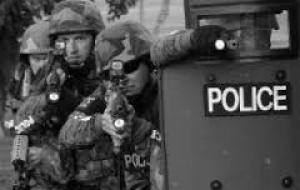
This is the fifth year the Drug War Chronicle has tallied drug war deaths. There were 54 in 2011, 63 in 2012, 41 in 2013, and 39 in 2014. That’s an average of just a hair under one a week during the past five years.The Chronicle’s tally only include deaths directly related to US domestic drug law enforcement operations — full-fledged, door-busting, pre-dawn SWAT raids, to traffic stops turned drug busts, to police buy-bust operations. Some of the deaths are by misadventure, not gunshot, including several people who died after ingesting drugs in a bid to avoid getting busted and two law enforcement officers who separately dropped dead while searching for marijuana fields.
The dead included three other police officers, two Hattiesburg, Mississippi, cops gunned down in a traffic stop turned drug search in May and a Memphis cop gunned down over a $20 pot deal in August.
But 90% of the drug war dead are civilians. While some of the deaths are accidental and some are clearly justifiable, as when people are actually shooting at police, others are more questionable. Were all those guys in vehicles who got killed because police “feared for their lives” really trying to run down and kill cops over a drug bust, or were they just trying to get away?
And some are just downright outrageous — one might even say criminal, although local prosecutors generally seem to disagree. In only one of the cases listed below was the police officer arrested, and in that case, she walked. Here are the worst drug war killings of 2015:
1. In February, Hummelstown, Pennsylvania, Police Officer Lisa Mearkle shot and killed David Kassick, 59, after he fled a traffic stop. Kassick was a relapsed heroin user who had done time in federal prison for heroin sales, and was carrying a needle and a spoon with residue on him. Video from Mearkle’s stun gun shows her repeatedly tazingKassick as he lay on his belly in the snow and yelling at him to show his hands as they jerk around from the tazingbefore firing two shots into his back four seconds apart. Mearkle was arrested on murder charges in April, but acquitted of murder charges in November.

2. In March, Volusia County, Florida, Sheriff’s Deputy Todd Raible shot and killed Derek Cruice, 26, during a dawn SWAT raid aimed at a small-time marijuana sales operation. Cruice, who was unarmed, was shot in the face. Police claimed they were “met with resistance and a shooting occurred,” but Cruice’sroommates vehemently disagreed. “He had no weapons on him or in the house,” roommate Steven Cochran told the Daytona Beach News Journal. “Nobody was making any kind of resistance or keeping them from doing their job.” Cruice wasn’t even wearing a shirt, he said. “It’s kind of hard to conceal anything or hide anything when this is all you have on. They entered the house and fired.” Another roommate bluntly called the deputy’s action’s “murder.” A grand jury directed by State Attorney R.J Larizza disagreed. In Ocober, it failed to indict Raible on any charge. Cruice was a popular figure in the local community, and there were protests over his death. The cops scored half a pound of weed and some cash, but no weapons in the raid.3. Also in March, also in Florida, Putnam County sheriff’s deputies shot and killed Andrew Anthony Williams, 48, as he attempted to flee in his vehicle from a “reverse sting.” That’s where cops pose as drug dealers, sell unwary customers small amounts of drugs, then arrest them. Deputies had successfully sold drugs to and arrested 10 people, but when they identified themselves and tried to arrest Williams, who was number 11, he declined. News 4 Jax had it this way: “…when they tried to arrest Williams, he took off in a blue SUV and, swerving to avoid deputies, ran into a tree. Williams then backed up and tried to take off again toward deputies causing four of them to open fire on Williams SUV, hitting him an unknown number of times.”
Williams’ death stinks for two reasons, First, reverse drug stings are a controversial tactic, sometimes arguably justifiable at the higher echelons of the drug trade, where selling sizeable quantities of drugs to a player to see where they go help crack a drug ring, but that logic isn’t at work here, where the only result is to round up some street drug buyers and drag them into the criminal justice system. Is having deputies pretend to be drug dealers to bust small-time users really the county’s best use of its law enforcement resources?
And then there’s the no-witness “he was going to run me over” defense used by the police to justify the killing. It happens not infrequently. Williams may have decided that getting busted on a minor dope charge was worth trying to murder a group of police officers with his vehicle. But could it have been that he was just trying to get away?
4. In April, 73-year-old Tulsa, Oklahoma, sheriff’s Reserve Officer Charles Robert Bates shot and killed meth and gun trafficking suspect Eric Harris when he mistakenly opened fire with his pistol instead of his Taser. The shooting occurred in the midst of a struggle as Harris had attempted to flee on foot and there is no evidence that Bates intended to kill Harris, but the killing led to scandal over Sheriff Stanley Glanz’s relationship with Bates and how the retiree volunteer managed to get in the middle of a Violent Crimes Task Force operation. Glanz was forced to resign in October and was indicted on a misdemeanor records tampering charge over his failure to release Bates’ personnel records. Those records indicate that even though top sheriff’s officials knew Bates wasn’t well-trained enough, they pressured others to ignore it. Bates himself was indicted for second degree manslaughter and goes on trial in April.
5. In July, Seneca, South Carolina, Police Officer Mark Tiller shot and killed 19-year-old Zachary Hammond. Hammond was behind the wheel of a car at fast food restaurant parking lot. He had driven there with a female passenger who was going to sell a small amount of marijuana to what turned out to be an undercover cop. Police said Hammond drove toward the officer, forcing him to fire, but that account was challenged by Eric Bland, an attorney representing Hammond’s family. Bland said that the autopsy report showed that Hammond had been shot from behind and that the vehicle was not moving. The autopsy showed a first shot entering the teen’s left rear shoulder and a second in his side five inches away that went through his heart and lungs before exiting his lower right side.
“It is clearly, clearly from the back,” Bland said after viewing pictures of the bullet wounds at the coroner’s office. “It is physically impossible for him to be trying to flee or run over the officer that shot him. This is a 19-year-old kid without a weapon in his car, clearly in the Hardee’s parking lot on a date, and within five minutes he has two shots that appear to be in his back and his side, from an officer shooting him from the back — and he’s dead and this family needs answers.”
The killing was egregious enough to spark a Justice Department investigation, which is still ongoing, but not enough to convince local prosecutors to go after Officer Tiller. In October, Solicitor Chrissy Adams declined to file criminal charges against Tiller. A federal wrongful death lawsuit filed by Hammond’s family is pending.

6. In September, a still unnamed member of an Akron, Ohio, SWAT team shot and killed Omar Ali, 27, during a raid on his hookah store. Police were investigating Ali for drug sales and domestic violence when they broke down the door to his business, then encountered him in the main room of his shop. Police said they ordered him to put his hands up, but he allegedly refused those commands and reached toward the back of his waistband. The unnamed SWAT officer then shot him. Police found no weapon in his waistband. What they did find was 2.8 grams of heroin and five doses of Suboxone hidden in his butt-crack.7. In July, a group of police officers in Southhaven, Mississippi, arrested Troy Goode, 30, after he was behaving erratically under the influence of LSD he had ingested in anticipation of a Widespread Panic concert. His wife attempted to drive him home, but at some point, he got out of the car and began creating a disturbance. Police were called, and they chased and arrested him, hogtieing him face down on a stretcher. He was charged with resisting arrest, then taken in an ambulance to a hospital, where he died two hours later. In December, the State Medical Examiner ruled that Goode had died of “LSD toxicity,” but given that there are no known cases of fatal LSD overdoses, that finding is hard to credit. Goode’s family isn’t buying it; they instead cite an,independent autopsy report that found Goode died after being hogtied and left prone for an extended period. That stress position caused him to have trouble breathing and, as his heart attempted to compensate, it went into cardiac arrhythmia. “He was suffocating. His heart increased into what is called tachycardia,” family attorney Tim Edwards said. “There is no scientific basis to attribute his death to LSD. This was lethal force, putting someone in a prolonged hogtied position,” Edwards said. “This was not a situation where a 300-pound man attacked a police officer in the dark. This was a science nerd.” The family has asked the Justice Department to file a civil rights investigation and says it plans to file a lawsuit over Goode’s death this month.

